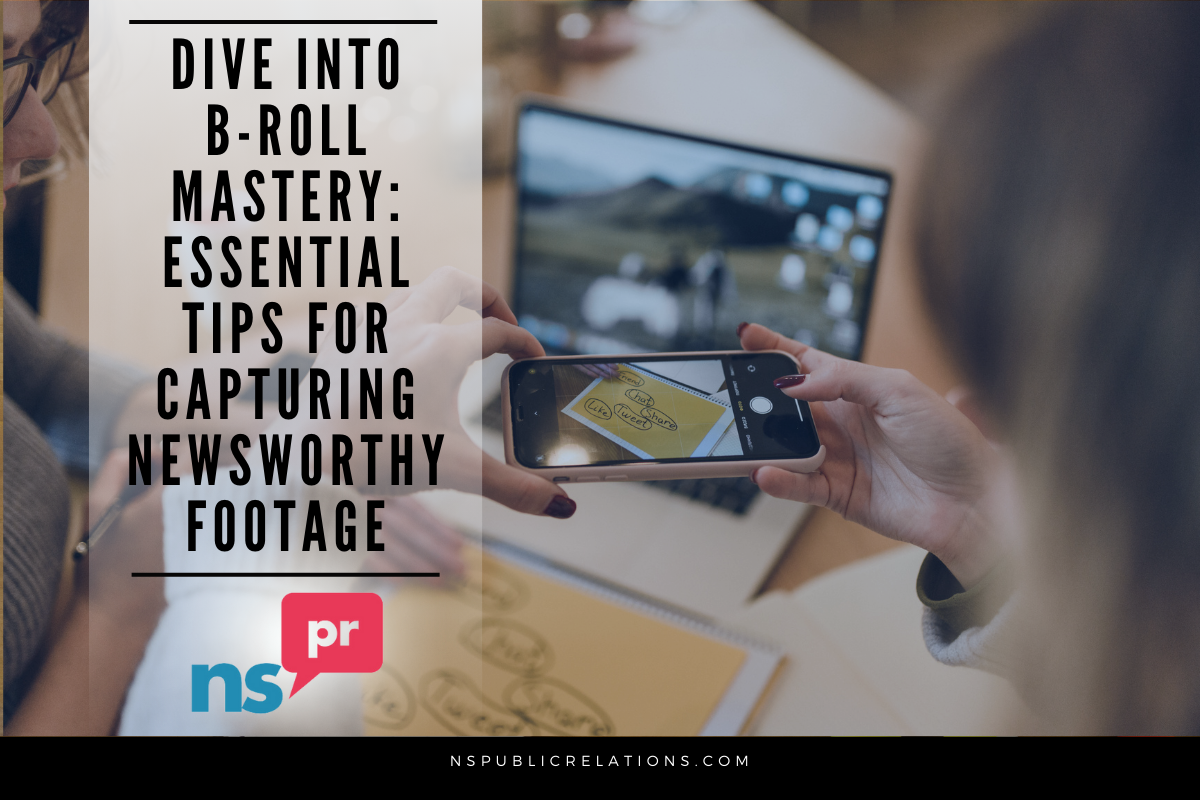
25 Apr Lights, Camera, Coverage: How B-Roll Can Secure Your Spot in the News
Today, we’re spilling the tea on a secret weapon that can help land you prime real estate in the news cycle: B-roll. Yep, you heard that right—those captivating visuals you see on the television didn’t just appear out of thin air. Someone had to take them and it might as well be you so you can land the coverage you want! Taking and sending photos and videos hold the key to securing coveted news coverage. So, buckle up, because we’re about to dive into the world of B-roll and uncover how it can catapult your story into the headlines!
So, what makes B-roll so irresistible to journalists? Well, for starters, it’s all about visual appeal. In today’s fast-paced digital landscape, eye-catching visuals are like catnip for media professionals. When you provide journalists with high-quality B-roll that complements your story, you’re essentially handing them ready-made content that’s primed for publication. And let’s face it—no one has time to sift through boring press releases when there’s a treasure trove of dynamic footage just waiting to be unleashed!
But wait, there’s more! B-roll isn’t just about looking pretty; it’s also about adding depth and dimension to your story. When journalists are busy (when aren’t they?), they will also have this depth at their fingertips (thanks to you). Think of it as the missing puzzle piece that completes the picture and brings your narrative to life. Whether it’s showcasing the hustle and bustle of a bustling city street, the infectious energy of a live performance, or the quiet serenity of a heartfelt moment, B-roll has the power to transport viewers directly into your story. And the more immersive and engaging your visuals are, the more likely journalists are to take notice and give your story the coverage it deserves.
First things first, let’s talk strategy. Before you even think about hitting record, take a step back and ask yourself: What’s the story I want to tell, and who’s the media I want to reach? Understanding your narrative is crucial for crafting B-roll that resonates with both journalists and viewers alike. Whether you’re unveiling a groundbreaking product, hosting a star-studded event, or sharing a heartwarming human-interest story, your B-roll should be tailor-made to capture attention and spark curiosity. Oh, and hold your phone horizontally at all times for B-roll please!
Of course, no discussion about B-roll would be complete without mentioning timing. If you want to maximize your chances of securing coverage, you need to strike while the iron is hot. That means having your B-roll shot and sent out, even sometimes when you’re on-location, is ideal. Get it done quickly!
Consider Clip Length: so, how long should your B-roll clips be? Well, there’s no one-size-fits-all answer, but here’s the scoop: shorter clips (around 5 to 10 seconds) are perfect for quick cutaways or highlighting specific details. They keep things snappy and hold the viewer’s attention without dragging on. When it comes to B-roll, it’s not about how long your clips are—it’s about how you use them to tell your story. Think of the 10/10/10 rule: 10 photos, 10 videos that are 10 seconds long!
On your phone: While smartphones are convenient for shooting on the fly, they can also be prone to shaky footage. To minimize camera shake, hold your phone with both hands and brace your elbows against your body. If you have access to a tripod or stabilizer, even better! Reporters have told us to stand still while taking B-roll and let people or things move across the screen. If you want to move, you must move with your feet versus your hands.
Last, there’s audio B-roll, also known as ambient sound or nat sound (natural sound), can add depth, atmosphere, and context to your footage. It’s the audio equivalent of visual B-roll, and it’s a crucial component of storytelling, especially in news reporting and documentary filmmaking. Hit record on your audio and get that natural sound of your story.
Okay, the real last point is, now you have to get the B-roll quickly to the media but these files are large. How will you do this? We know first-hand sending large B-roll files to journalists can be a challenge, especially when email attachments have size limitations. However, there are several alternative methods you can use to share your footage effectively such as file sharing services (WeTransfer, Dropbox).
When sharing B-roll footage with journalists, it’s also crucial to provide relevant information such folders with titles that explain what the B-roll is. You will want to note any usage restrictions or permissions associated with the footage. Clear communication and easy access to the files will help streamline the process and ensure that journalists have everything they need to tell your story effectively.
And there you have it, folks—our crash course in using B-roll to secure news coverage. From crafting compelling visuals to perfecting your timing, there’s no shortage of ways to make your story stand out in a crowded media landscape. So, the next time you’re gearing up for a PR push, don’t forget to bring out the big guns—grab your phone, roll out the B-roll, and get ready to make headlines!
For a quick guide to apply this to your next event, here are the highlights:
- B-roll should be eye-catching and add depth to your stories
- When using your phone, make sure you hold it horizontally
- To avoid taking shaky videos, hold your phone with both hands and elbows by your side
- Use the 10/10/10 rule: 10 photos, 10 videos that are 10 seconds long
- Send your visuals as soon as you can following the event
- Make sure to add the description of your visuals so journalists have all of the information they need to tell your story


No Comments